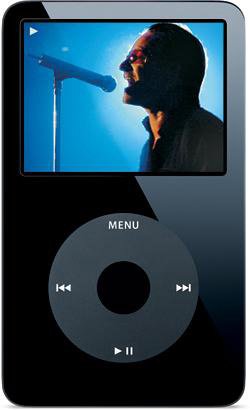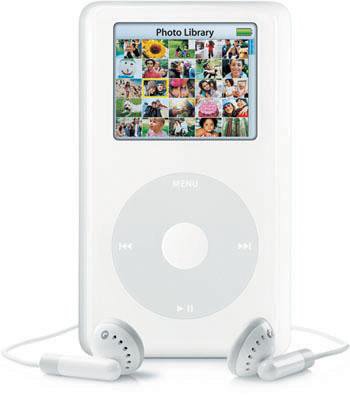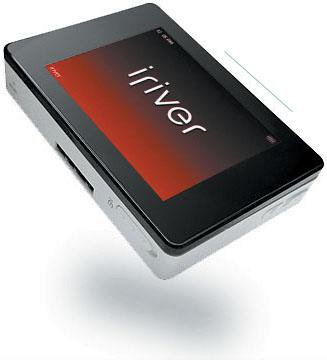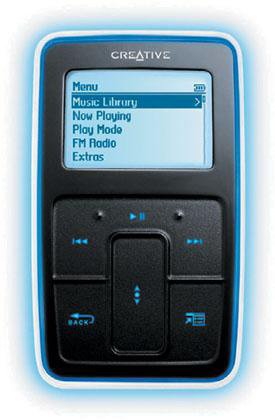Listening to Podcasts
| So now you know where to find and how to obtain your podcasts. How are you going to listen to them? Several options are available to you, depending on what software you are using. First, if you are using a program with a built-in media player, you can enjoy the podcasts on your computer using said player. If you want to use a digital music device, such as an iPod or a Nomad, you must get the podcast downloaded onto your player. There are many ways to do both, as you'll see in this section. Software-Based (Computer) PlayersFor those who like to listen to their podcasts directly on their home (or work) computers, a software-based media player is the answer. If the podcast aggregator you are using does not include a built-in media player, and you are not using a program like Apple's iTunes for Mac or Windows, you need to ensure that you have some other form of media player installed on your computer so that you can to listen to the podcasts as they arrive. Many media players are available in cyberspace. Just about every sound card ever made comes with a media player, as do most video cards, be they from Matrox, NVidia, or ATI. In fact, there are so many media players for Windows-based machines that I could write an entire book on them. Not to worry. Despite the vast array of media players floating around, the ubiquity (and utility) of the "big three" means that I need to discuss only those three options: Windows Media Player, RealPlayer, and QuickTime. QuickTime www.apple.com/quicktime Operating System: Macintosh, Windows The granddaddy of all media players, QuickTime (Figure 2.51) is Apple's entry in the media-player sweepstakes. Introduced in late 1991, QuickTime has evolved and constantly pushed the envelope in doing so. Today, QuickTime is the media player of choice for movie studios when they want to put their trailers out on the World Wide Web. Indeed, QuickTime boasts the highest quality of all of the media players. Figure 2.51. QuickTime is what the movie studios often use when they put their trailers out on the 'net.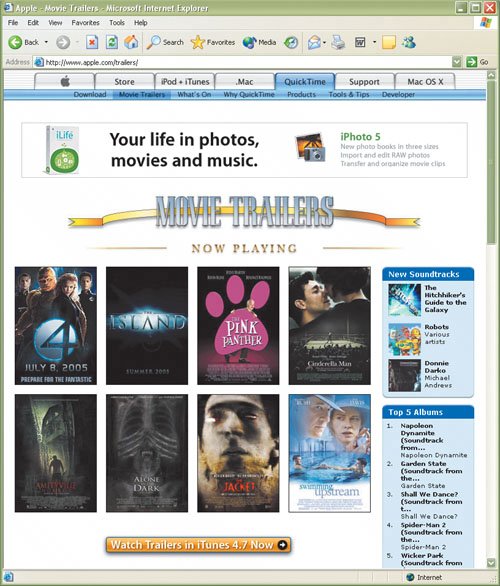 Perhaps the biggest bonus that QuickTime offers is that it is seamlessly integrated into iTunes. Because the majority of digital music devices are iPods, it makes sense that iTunes and QuickTime will be oft-used software in the world of podcasting. The basic version of QuickTime is free, and it does everything a podcast enthusiast needs. The other main factor with QuickTime is quality, and although this is open for debate, few people will dispute that QuickTime is the hands-down winner when it comes to image and sound quality. RealPlayerwww.real.com Operating System: Windows, Macintosh, Linux/Unix RealPlayer (Figure 2.52) is the main cog in the RealNetworks wheel. First released in 1995, RealPlayer has long been a favorite of many users, and it arguably has driven many of the innovations in media players. The latest version of RealPlayer, version 10.5, can play CDs, DVDs, audio DVDs, video, and audio, and also allows users to burn CDs. As a bonus, RealPlayer has a TiVo-like feature that allows you to buffer streaming content, such as Internet radio broadcasts. If you dislike Windows Media Player and feel like being closer to the cutting edge, RealPlayer is a good choice. Figure 2.52. RealPlayer is a very respectable media player.
The complaints with regard to RealPlayer revolve around the playback quality of the media (although this is entirely a matter of taste and opinion) and the installation process. If you want to get the latest and greatest from RealNetworks, for example, you must pay for it. We're not against this, but compared with WMP's free status, there are decisions to be made: cutting-edge technology versus cost. Windows Media Player (WMP)www.microsoft.com/windows/windowsmedia/default.aspx Operating System: Windows, Macintosh Windows Media Player is the default media player from Microsoft Corporation. Because the vast majority of home computers run Windows software, this means that nearly everyone has Windows Media Player (or some version of it) installed. Because this software is free, updates for it can be downloaded at no cost so that users can keep up to date with the latest advances in media-player technology. The current version of this software is Windows Media Player 10 (Figure 2.53), which is available for download at Microsoft's Web site. Windows Media Player can play MP3 files, video files, picture slide shows, and Internet radio, making it a fantastic one-stop basic media player. Don't forget that WMP also plays compact discs, DVD movies, audio DVDs, and MP3 CDs. For Windows users, I recommend Windows Media Player if for no other reason than that you probably already have it on your machine. Figure 2.53. Windows Media Player 10 in action.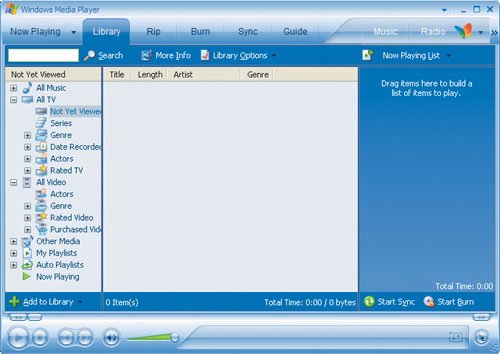
If you update your Windows software regularly with the Automatic Update feature, your version of Windows Media Player will most likely be current. MP3 PlayersAlthough you can listen to podcasts on your computer, the main thrust of the podcasting movement is to make podcasts portable, allowing them to be played on iPods and other digital music devices, including SmartPhones and PDAs. There are more digital music players, Smart-Phones, and PDAs on the market than you can shake a stick at, although in the past 3 years Apple has so thoroughly dominated the field that I must include plenty of Apple products in any analysis of these devices. That said, by sticking to the top few devices in each category, I can give you an idea of what is out there and what the feature sets are. Before I delve into examining various digital music and video players, however, I need to reinforce the utter dominance of Apple's iPod. According to media reports, at this writing Apple controls more than 80 percent of the total digital music player (MP3 player) market, so I'd be remiss if I didn't focus heavily on these players.
Although I have included prices for the MP3 players in this section, the market changes so frequently that both prices and model features are likely to have changed (and/or improved) by the time you read this book. This section is intended just to give you a feel for what's out there. Archos Gmini 500 Manufacturer: Archos (www.archos.com) Price: $699 Memory Type: Hard drive Memory Size: 40 GB Weight: 11.2 ounces Screen: Yes/color (4 inches, 480x272, 262,000 colors) Battery: Internal/rechargeable OS Compatibility: Windows XP The Archos is a high-end portable video, audio, photo, and music player with a stunning 4-inch color screen. The price reflects the high-end nature of this device, but when video podcasting enters the equation, having a larger and brighter screen is important. The features of the Archos Gmini 500 are as follows:
If a high-end, all-in-one video device is what you're looking for, the Gmini must be considered for its large, crisp color screen, if for no other reason. The addition of plenty of useful features makes it a worthy option, although a very pricey one. iAudio U2 Manufacturer: COWON America (http://eng.iaudio.com) Price: $180 Memory Type: Flash Memory Size: 1 GB Weight: 1.2 ounces Screen: Yes Battery: Internal/rechargeable OS Compatibility: Macintosh, Windows COWON America's iAudio U2 digital music player is an excellent flash-based player for both the Mac and Windows operating systems. One of the distinct benefits of the U2 over the iPod shuffle is the inclusion of a screen, although admittedly, the U2 is also larger than the shuffle. The U2 comes with a built-in, rechargeable lithium battery that should give you 18 to 20 hours of playback before the device needs to be recharged. The U2 comes not only as a 1 GB model, but also in 128 MB, 256 MB, and 512 MB flavors. Following are the prime features of the iAudio U2:
iPod Manufacturer: Apple (www.apple.com) Price: $299 or $399 Memory Type: Hard drive Memory Size: 30 GB (7,500 songs) or 60 GB (15,000 songs) Weight: 5.5 ounces Screen: Yes/color (2.5 inches) Battery: Internal/rechargeable OS Compatibility: Macintosh, Windows The classic-style (that is, the iPods most like the original iPods in design) iPods available at this writing are the 30 GB and 60 GB video iPods. These are the most functional iPods ever created, capable of holding thousands of pictures, movies, video podcasts, music, audio-books, and contact databases. These are truly monster machines that, despite their huge hard drives and incredible capabilities, are actually smaller than previous iPod generations. With a very easy-to-use interface that has been copied by its competition, the iPod combines impressive styling with user-friendly features that have propelled it to the top of the heap. The screen on the iPod is a QVGA 320x240 2.5-inch color screen, which makes navigating the menus a treat. The basic features of the iPod are
iPod Nano Manufacturer: Apple (www.apple.com) Price: $149/$199/$249 Memory Type: Flash Memory Size: 1 GB (240 songs)/2 GB (500 songs)/4 GB (1,000 songs) Weight: 1.5 ounces Screen: Yes/color (1.5 inches) Battery: Internal/rechargeable OS Compatibility: Macintosh, Windows Photo courtesy of Apple Computer, Inc The iPod nano is an amazing little device. Capable of storing music, audiobooks, podcasts, and contact information, the nano can also be used to store (and display) thousands of digital photographs. Incredibly small and light, the nano is also very tough. When it was first released, someone on the Web tested it by dropping it, throwing it, and eventually running over it with a car, and even after all that, it still worked (although the screen packed it in after the car ran over it). The iPod nano is the iPod for those folks who value space above all else. Only slightly thicker than a few credit cards stacked together, and only slightly wider than a pack of gum, the nano is a joy to tote around when traveling or exercising. The only limitation is its relatively small storage. If keeping your entire music collection on hand is important to you, the iPod nano shouldn't be your first choice. The nano, however, is the coolest digital music device out there, in my book. iPod Photo Manufacturer: Apple (www.apple.com) Price: $349/$449 Memory Type: Hard drive Memory Size: 30 GB (7,500 songs)/60 GB (15,000 songs) Weight: 5.9 ounces/6.4 ounces Screen: Yes/color Battery: Internal/rechargeable OS Compatibility: Macintosh, Windows Photo courtesy of Apple Computer, Inc Note that the iPod photo is still for sale in some places, but it's not actively being manufactured by Apple anymore. The iPod photo is an iPod with the added benefit of a color screen and the ability to store thousands of photographs (in digital form) as well as music. Before you scratch your head wondering why anyone would want to combine these two things, let me point out that the ability to listen to music while a slide show of your latest vacation pictures zips by is surprisingly compelling and enjoyable. With the video/audio output cable, the iPod photo can be turned into a portable slide-show machine, displaying pictures while serenading viewers with music of the operator's choice. The iPod photo can hold up to 60 GBmore than enough to store a couple hundred CDs and a few thousand of your favorite pictures. iPod Shuffle Manufacturer: Apple (www.apple.com) Price: $69/$99 Memory Type: Flash Memory Size: 512 MB (120 songs)/1 GB (240 songs) Weight: 0.78 ounce Screen: No Battery: Internal/rechargeable OS Compatibility: Macintosh, Windows Photo courtesy of Apple Computer, Inc The iPod shuffle raised a lot of eyebrows, because it is a flash-memory-based player rather than a hard-drive-driven device. Add to that the fact that the shuffle doesn't have a built-in screen, and it would seem that Apple took a very big risk. Risk or no risk, upon its release, the public immediately fell in love with the iPod shuffle, and waiting lists to buy it were in the 6- to 8-week range! Despite lacking a screen, the iPod shuffle is an outstanding digital music device that is arguably smaller than a seven-stick pack of chewing gum. The shuffle has the following functions: play, rewind, fast-forward, previous song, next song, pause, volume up/down, and play songs in order or shuffle songs. Although using an MP3 player without a screen as a podcast player may seem strange, I use my iPod shuffle for just that. In iTunes, I transfer two or three podcasts to the shuffle; then it's off to the gym. I strongly recommend that you use iTunes if you are going to purchase a shuffle; only when these two products work together does the iPod shuffle really sing.
Song-count disparity: Why does a Creative Zen Touch with 20 GB of hard-drive space boast that it can hold 10,000 songs when an Apple iPod with the same-size hard drive offers half as much? The answer lies in the details. The number of songs or podcasts that can fit on a digital music device depends entirely on the quality of the recordings you are storing. If you don't mind your songs sounding like they are coming across two tin cans with a wire between them, a 20 GB iPod could hold about 50,000 songs. So rememberlook at the size of the hard drive and not the boasts about the number of songs a player can hold. In the case of the players discussed in this chapter, all of them have 20 GB hard drives, and even though the various manufacturers predict that each player can store a certain number of songs, one player will not store more than another, with everything else being equal. iRiver U10 Manufacturer: iRiver (www.iriver.com) Price: $249.99 Memory Type: Flash Memory Size: 1 GB Weight: 2.5 ounces Screen: Yes/color Battery: Internal/rechargeable OS Compatibility: Windows XP iRiver has moved away from hard-drive-based players and now offers only flash-based players. Its U10 has a very small form factor and fits nicely into the palm of your hand. It has the ability to display photographs, videos, and music, or to play games. Perhaps the most enticing feature of the U10 is its battery life of more than 24 hoursa bonus no matter what kind of player you're talking about. Available only for Windows PCs, the iRiver has an impressive array of features, including:
When you're shopping for a Windows-based digital music device, you cannot ignore the iRiver U10. The inclusion of an FM radio and a built-in voice recorder automatically save money compared with Apple's iPods, for which those features are available only as add-ons. That said, the U10 has very limited storage spaceonly 1 GB. Zen Micro Manufacturer: Creative (www.creative.com) Price: $179.99/$199.99/$229.99 Memory Type: Hard drive Memory Size: 4 G/5 GB/6 GB Weight: 3.08 ounces Screen: Yes/monochrome Battery: Internal/rechargeable OS Compatibility: Windows The Zen Micro is a great little MP3 player with tons of functionality. The Micro comes with an FM tuner/recorder so that you can record straight off of FM radio, as well as a built-in voice recorder so that you can record lectures, personal notes, meetings, and the like. Capable of holding contact information and even synchronizing with Microsoft Outlook, the Zen Micro is a great alternative to the iPod. The downside to the Micro probably is its menu system, which I personally don't find as intuitive as Apple's. But the sound quality is high, there are 10 colors to choose among, and an FM radio (something that costs extra with an iPod) is included, all of which make the Micro a viable alternative. Zen Vision:M Manufacturer: Creative (www.creative.com) Price: $349.99 Memory Type: Hard drive Memory Size: 30 GB Weight: 5.75 ounces Screen: Yes/color (2.5 inches, 320x240) Battery: Internal/rechargeable OS Compatibility: Windows XP The Creative Vision:M claims a 14-hour battery life for a unit that can store 120 hours of movies, tens of thousands of photos, and up to 15,000 songs. Those are some significant boasts, but the Vision:M pulls them off and then some. This is a true challenger to Apple's video iPod, and in some ways, the Vision:M matches up very well, although there are a few shortcomings. The feature list includes
The Zen Vision:M has won many industry awards, and I have to say that it's a very impressive unit. The main limitation is the somewhat-clunky interface, but for what you get in terms of value for the money, the Zen Vision:M is an amazing unit.
Beauty is in the eye of the beholder. Nowhere is that more true than when choosing a digital music player. Because everyone has a different opinion of what looks good and what is easy to use, I strongly suggest that you head to your nearest electronics store and test these units head to head before making a decision. |
EAN: 2147483647
Pages: 89








